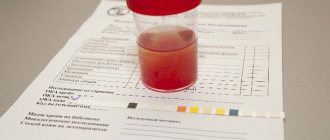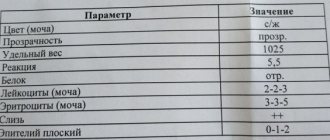A general urine test is a mandatory test for diagnosing various diseases. But sometimes it does not allow making an accurate diagnosis in order to prescribe the correct treatment. In such cases, a urine test according to Nechiporenko is prescribed. It is a microscopic examination. During this process, the number of cylinders, red blood cells and white blood cells in 1 ml of urine is counted using a special counting chamber. This allows you to accurately assess the condition of the urinary system.
Indications for testing
The main indication for prescribing a urine test according to Nechiporenko for adults and children is the detection of deviations in the results obtained after a general urine test. The study can confirm the development of a certain pathology or classify deviations from the norm as random.
Indications for urine analysis according to Nechiporenko are the appearance of symptoms that may indicate the development of serious pathologies. This is, first of all, cloudiness of the urine, as well as a change in its color and smell. The study is also prescribed in the following cases:
- If you experience pain in the lumbar region, which may indicate kidney problems.
- When changing the frequency of urination and the amount of urine.
- If blood is detected in the urine.
- For systemic diseases that increase the risk of renal dysfunction.
- During preventive examinations.
Mandatory tests include urine analysis according to Nechiporenko during pregnancy. It allows you to promptly detect malfunctions in the functioning of the urinary system. Thanks to this, it will be possible to purchase the necessary products at an affordable price to support a woman’s body while bearing a child.
General information
In most cases, this test is prescribed if the results of basic studies reveal irregularities or are questionable. The analysis determines the amount of important elements in the sediment. This makes it possible to confirm or refute the suspected diagnosis (for example, hematuria). The difference between this test and clinical analysis is that in the first case the elements are counted per unit volume, and in the second - in the field of view.
Indications for the study
Urinalysis according to Nechiporenko can be prescribed to both adult patients and children. Indications for its implementation include symptoms of urinary tract diseases, abnormal results of other tests, and a high risk of kidney damage (for example, in diabetes). The test may also be prescribed at certain intervals to monitor the progress of treatment. Pathologies of the kidneys and urinary tract can be suspected if there are symptoms such as pain in the lumbar region, difficulty urinating, a change in the usual smell or color of urine.
Collection of biomaterial
To exclude false results, 12 hours before the test you must avoid foods that color your urine, as well as salty and spicy foods. Diuretics are usually discontinued two days before the test. This is done only by the decision of the attending physician; unauthorized withdrawal of medications is unacceptable. To perform this test, an average portion of urine (morning or afternoon) is required. If urine is collected during the day, the period between urinations should be 4-6 hours.
Urine is collected in three sterile containers. The volume of the middle portion should be the largest. It is important to deliver the biomaterial to the laboratory no later than 2 hours after its collection.
Interpretation of results
The test is used as an auxiliary study, so its results are interpreted in conjunction with data obtained from other tests. Normally, one milliliter of biomaterial should contain up to 1 thousand units of erythrocytes, up to 2 thousand leukocytes and up to 20 cylinders of each type. Deviations from the norm indicate an inflammatory process or pathology. Based on the results, a specific disease can be identified. For example, an increase in red blood cells is usually accompanied by neoplasms in the urinary tract or kidneys. If the results obtained seem questionable to the doctor, the test is repeated. Interpretation of the results can only be done by a doctor. A large number of additional factors are taken into account.
An increase in the number of red blood cells can be caused by excessively intense physical activity. This is also observed in the case of trauma to the urethra with a catheter, and menstrual fluid entering the urine.
The test results can be affected by many medications. It is important to inform your doctor if you are taking any medications.
Peculiarities
The analysis involves examining urine sediment. To do this, the biomaterial is poured from a sterile container into a test tube and mixed. After this, the vessel is placed in a centrifuge and the sediment is separated. After this, it is carefully examined in a volume of 1 ml in a chamber equipped with a special counter. The obtained data is multiplied by the provided coefficients to correctly reflect the level of structures.
Violations of the rules for urine collection most often lead to unreliable results. The risk of data distortion increases when storing biomaterial in non-sterile containers.
Analysis indicators
Many people are interested not only in how the Nechiporenko urine test is performed, but also in what it shows. Deviation from the norm towards an increase in the number of leukocytes indicates the presence of inflammatory and infectious processes. In this case, to make a diagnosis, an additional test for the presence of pathogenic microorganisms in the urine is prescribed. This will allow you to buy the necessary medications in accordance with the doctor’s recommendations and carry out effective therapy. A small number of white blood cells in the urine indicates normal functioning of the immune system.
Confirmation of a large number of red blood cells in the urine indicates damage to the urinary system. The main function of red blood cells is to transport oxygen through tissues. They should be present in the urine in minimal quantities. Exceeding their permissible amount may indicate the development of serious diseases, in particular the following:
- Tumor processes in the kidneys.
- Kidney tuberculosis.
- Urolithiasis.
- Glomerulonephritis.
- Intoxication of the body.
Also an important indicator of urine analysis according to Nechiporenko is the number of cylinders. They are special casts that occur when protein is present in the urine. This substance, under the influence of an acidic environment, coagulates, forming compressed elements called cylinders. Their number may be insignificant during intense physical activity and emotional stress. But a large number indicates the development of serious pathologies: glomerulonephritis, renal failure, kidney tuberculosis, etc. In addition, exceeding standard indicators may indicate the risks of rejection of a donor kidney.
The norm is considered to be a quantity not exceeding the following values:
- For red blood cells 1000/ml.
- For leukocytes 2000/ml
- For 20/ml cylinders
Urinalysis according to Nechiporenko: indications, preparation, standards
No medical examination is complete without a urine test. A general urine test is perhaps one of the most frequently prescribed tests. And this is not just a tribute to medical tradition: using this method, you can obtain data valuable for making a diagnosis, prescribing and monitoring treatment. But sometimes a general analysis is not enough.
In what cases is a urine test according to Nechiporenko prescribed? What kind of research is this? What is it for? Let's figure it out.
Urinalysis according to Nechiporenko - what is it?
If in a general urine analysis some changes were identified that make it difficult to make unambiguous diagnostic conclusions, then to clarify and detail them, a urine test according to Nechiporenko may be called.
It is performed with a microscope. In this case, the number of leukocytes, red blood cells, and so-called cylinders in 1 milliliter of urine is calculated.
Why is a urine test according to Nechiporenko prescribed?
Indications for its implementation vary. It is used to identify various inflammatory processes in the urinary system (kidneys, bladder, urethra); for the purpose of assessing kidney damage in a number of systemic diseases; to distinguish between urinary tract diseases; for the purpose of monitoring treatment.
Pyelonephritis: what is this disease and how to treat it? Urologist at Clinic Expert Kursk says:
Devyatkin Alexander Alexandrovich
What does the Nechiporenko test show?
A significant number of red blood cells may indicate damage to any part of the urinary system.
An increase in the number of leukocytes is observed during local inflammatory, infectious processes, etc. In such cases, it is additionally necessary to perform a urine test for the presence of bacteria in it.
In addition to erythrocytes and leukocytes, the study of cylinders is important. What are they? These are accumulations of protein that form from cells and cellular debris when the properties of urine change. The place of their formation is the renal tubules. There are several types of cylinders (epithelial, hyaline, etc.)
What are the reasons for the increase in this or that indicator?
Increased red blood cells in the urine. Looking for reasons
The number of red blood cells increases with urolithiasis; trauma, tuberculosis and kidney tumors; glomerulonephritis, severe pyelonephritis, etc.
The number of red blood cells can also increase in pathologies not directly related to the kidneys. These include hemophilia, benign prostatic hypertrophy, leukemia (leukemia), congestive heart failure, systemic lupus erythematosus and a number of others.
Following Queen Victoria's gene: what is hemophilia? The head of the hemostasis study group of the department for optimizing the treatment of hematological diseases of the Center named after. Dmitry Rogacheva, Doctor of Medical Sciences
Zharkov Pavel Alexandrovich
Leukocytes are elevated. Why?
An increase in their number in the urine is observed in acute pyelonephritis, glomerulonephritis, cystitis, kidney tuberculosis, bladder neoplasm, etc.
Cystitis: symptoms, diagnosis and treatment. Read more
Casts in urine. What does it mean?
Depending on their type, their number increases with intense physical activity, glomerulonephritis, heavy metal poisoning, acute and chronic renal failure, emotional stress, kidney damage due to diabetes, kidney tuberculosis, etc.
Ultrasound or MRI for kidney disease? The chief doctor of MRI Expert Yelets, Vladimir Vladimirovich Tulinov, tells
Preparation for urine analysis according to Nechiporenko
For 12 hours before the test, do not eat spicy, salty foods, as well as foods that change the color of urine (for example, beets, carrots).
For 48 hours before urine collection, stop taking diuretics (only after agreeing on this with your doctor).
How to properly collect urine for analysis according to Nechiporenko?
First, the external genitalia are toileted. An average portion of morning urine is collected.
How many days does it take to prepare a urine test according to Nechiporenko?
It depends on the workload of the laboratory. As planned - 1 working day.
Can urine for analysis be stored in the refrigerator?
The urine sample must be fresh. However, if the situation does not allow you to donate urine immediately before the test, you should store it in the refrigerator at a temperature of +2...+8°C. The total time of storage and delivery to the laboratory is no more than twelve hours from the moment the material is taken. It is necessary to clarify all these nuances in advance in the laboratory, clinic, etc., where the analysis will be carried out.
How to read the analysis correctly? Urine sample standards according to Nechiporenko
Normally the indicators are:
— leukocytes: 0 — 2000/ml
— red blood cells: 0 — 1000/ml
- cylinders: not detected
You can sign up for the study here or in the contacts section
Historical reference
This analysis was proposed by the Soviet military surgeon, urologist-oncologist Alexander Zakharovich Nechiporenko.
The birthplace of the future doctor was the Volyn province of the Russian Empire (today the Zhytomyr region of Ukraine).
A year before the start of the Great Patriotic War, Alexander Zakharovich graduated from the Kiev Medical Institute.
In the first years after the war, he trained in the field of thoracic surgery at the leading educational institution for training military doctors - the Leningrad Military Medical Academy.
Since the mid-60s he has been working at the Rostov Medical Institute at the Department of Surgery.
In 1967, Nechiporenko became the scientific director of the oncourological department of the Research Institute of Oncology and Medical Radiology in Rostov-on-Don. For more than 10 years he was the head of the urology course at the Medical Institute of Grodno (Belarus).
He is a pioneer of the method of removing the bladder for bladder cancer and removing lymph nodes for malignant neoplasms of the testicle.
He passed away in November 1980 at the age of 65.







